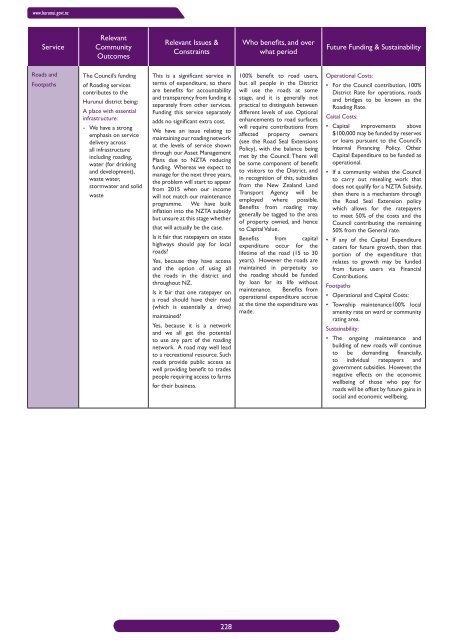Long Term Community Plan 2012-2022 - Hurunui District Council
Long Term Community Plan 2012-2022 - Hurunui District Council
Long Term Community Plan 2012-2022 - Hurunui District Council
You also want an ePaper? Increase the reach of your titles
YUMPU automatically turns print PDFs into web optimized ePapers that Google loves.
www.hurunui.govt.nz<br />
Service<br />
Relevant<br />
<strong>Community</strong><br />
Outcomes<br />
Relevant Issues &<br />
Constraints<br />
Who benefits, and over<br />
what period<br />
Future Funding & Sustainability<br />
Roads and<br />
Footpaths<br />
The <strong>Council</strong>’s funding<br />
of Roading services<br />
contributes to the<br />
<strong>Hurunui</strong> district being:<br />
A place with essential<br />
infrastructure:<br />
- We have a strong<br />
emphasis on service<br />
delivery across<br />
all infrastructure<br />
including roading,<br />
water (for drinking<br />
and development),<br />
waste water,<br />
stormwater and solid<br />
waste<br />
This is a significant service in<br />
terms of expenditure, so there<br />
are benefits for accountability<br />
and transparency from funding it<br />
separately from other services.<br />
Funding this service separately<br />
adds no significant extra cost.<br />
We have an issue relating to<br />
maintaining our roading network<br />
at the levels of service shown<br />
through our Asset Management<br />
<strong>Plan</strong>s due to NZTA reducing<br />
funding. Whereas we expect to<br />
manage for the next three years,<br />
the problem will start to appear<br />
from 2015 when our income<br />
will not match our maintenance<br />
programme. We have built<br />
inflation into the NZTA subsidy<br />
but unsure at this stage whether<br />
that will actually be the case.<br />
Is it fair that ratepayers on state<br />
highways should pay for local<br />
roads?<br />
Yes, because they have access<br />
and the option of using all<br />
the roads in the district and<br />
throughout NZ.<br />
Is it fair that one ratepayer on<br />
a road should have their road<br />
(which is essentially a drive)<br />
maintained?<br />
Yes, because it is a network<br />
and we all get the potential<br />
to use any part of the roading<br />
network. A road may well lead<br />
to a recreational resource. Such<br />
roads provide public access as<br />
well providing benefit to trades<br />
people requiring access to farms<br />
for their business.<br />
100% benefit to road users,<br />
but all people in the <strong>District</strong><br />
will use the roads at some<br />
stage, and it is generally not<br />
practical to distinguish between<br />
different levels of use. Optional<br />
enhancements to road surfaces<br />
will require contributions from<br />
affected property owners<br />
(see the Road Seal Extensions<br />
Policy), with the balance being<br />
met by the <strong>Council</strong>. There will<br />
be some component of benefit<br />
to visitors to the <strong>District</strong>, and<br />
in recognition of this, subsidies<br />
from the New Zealand Land<br />
Transport Agency will be<br />
employed where possible.<br />
Benefits from roading may<br />
generally be tagged to the area<br />
of property owned, and hence<br />
to Capital Value.<br />
Benefits from capital<br />
expenditure occur for the<br />
lifetime of the road (15 to 30<br />
years). However the roads are<br />
maintained in perpetuity so<br />
the roading should be funded<br />
by loan for its life without<br />
maintenance. Benefits from<br />
operational expenditure accrue<br />
at the time the expenditure was<br />
made.<br />
Operational Costs:<br />
• For the <strong>Council</strong> contribution, 100%<br />
<strong>District</strong> Rate for operations, roads<br />
and bridges to be known as the<br />
Roading Rate.<br />
Caital Costs:<br />
• Capital improvements above<br />
$100,000 may be funded by reserves<br />
or loans pursuant to the <strong>Council</strong>’s<br />
Internal Financing Policy. Other<br />
Capital Expenditure to be funded as<br />
operational.<br />
• If a community wishes the <strong>Council</strong><br />
to carry out resealing work that<br />
does not qualify for a NZTA Subsidy,<br />
then there is a mechanism through<br />
the Road Seal Extension policy<br />
which allows for the ratepayers<br />
to meet 50% of the costs and the<br />
<strong>Council</strong> contributing the remaining<br />
50% from the General rate.<br />
• If any of the Capital Expenditure<br />
caters for future growth, then that<br />
portion of the expenditure that<br />
relates to growth may be funded<br />
from future users via Financial<br />
Contributions.<br />
Footpaths<br />
• Operational and Capital Costs:<br />
• Township maintenance100% local<br />
amenity rate on ward or community<br />
rating area.<br />
Sustainability:<br />
• The ongoing maintenance and<br />
building of new roads will continue<br />
to be demanding financially,<br />
to individual ratepayers and<br />
government subsidies. However, the<br />
negative effects on the economic<br />
wellbeing of those who pay for<br />
roads will be offset by future gains in<br />
social and economic wellbeing.<br />
228

















